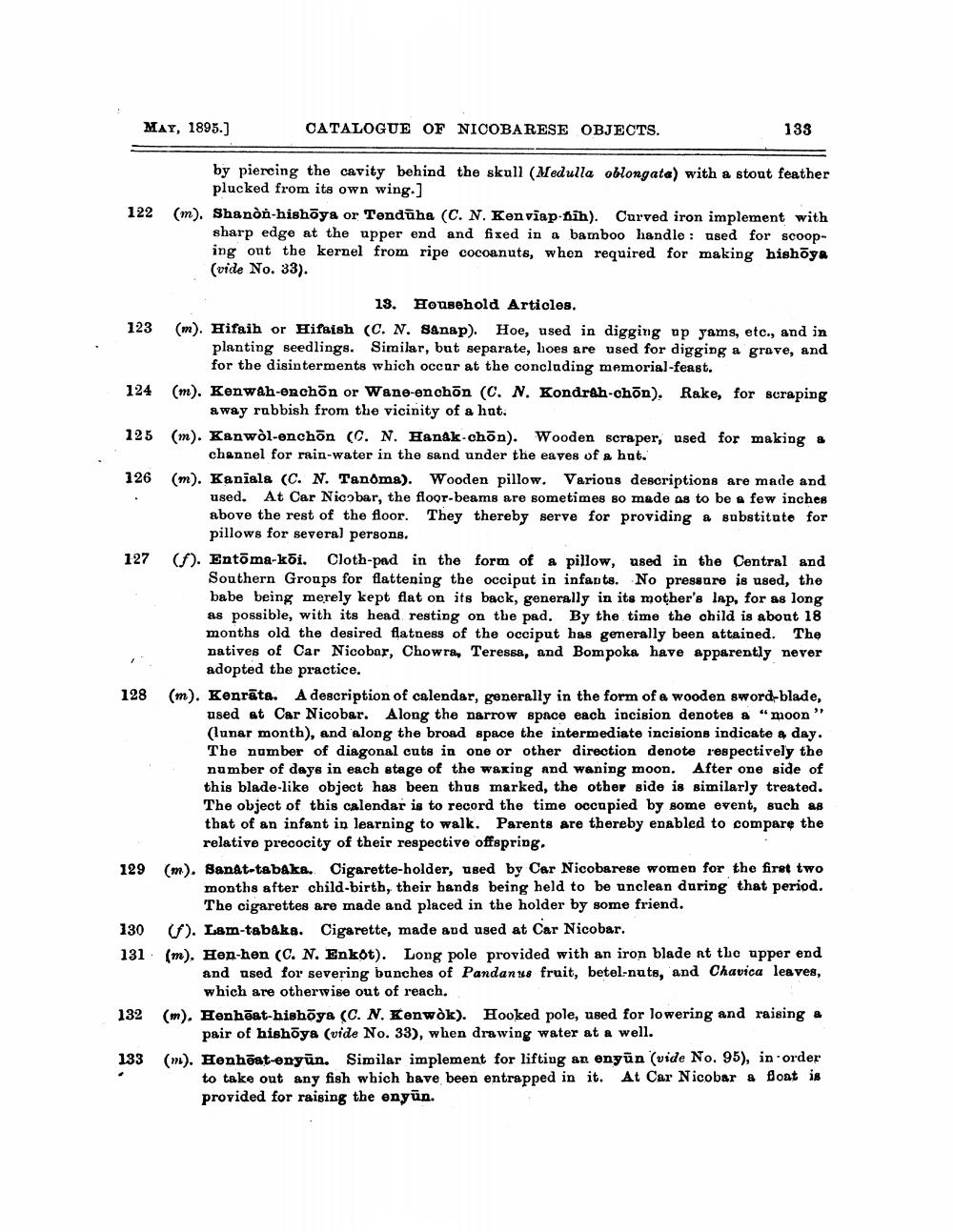________________
MAY, 1895.)
CATALOGUE OF NICOBARESE OBJECTS.
133
122
by piercing the cavity behind the skull (Medulla oblongata) with a stout feather
plucked from its own wing.] (m), Shanòn-hishoya or Tendūha (C. N. Ken viap-tih). Curved iron implement with
sharp edge at the upper end and fixed in a bamboo handle : used for scooping ont the kernel from ripe cocoanuts, when required for making hishoya (vide No. 33).
13. Household Articles. 123 (m). Hifain or Hifaish (C. N. Sanap). Hoe, used in digging np yams, etc., and in
planting seedlings. Similar, but separate, hoes are used for digging a grave, and
for the disinterments which occar at the concluding memorial-feast. 124 (m). Kenwah-enchon or Wane-enchon (C. N. Kondrah-chồn), Rake, for scraping
away rubbish from the vicinity of a hat. 125 (m). Kanwòl-enchon (C. N. Hanák-chon). Wooden scraper, used for making a
channel for rain-water in the sand under the eaves of a hot. 126 (m). Kaniala (C. N. Tanoma). Wooden pillow. Various descriptions are made and
used. At Car Nicobar, the floor-beams are sometimes so made as to be a few inches above the rest of the floor. They thereby serve for providing a substitute for
pillows for several persons. 127 (). Entöma kõi. Cloth-pad in the form of a pillow, used in the Central and
Southern Groups for flattening the occiput in infants. No pressure is used, the babe being merely kept flat on its back, generally in its mother's lap, for as long as possible, with its head resting on the pad. By the time the child is about 18 months old the desired flatness of the occiput has generally been attained. The natives of Car Nicobar, Chowran Teressa, and Bompoka have apparently never
adopted the practice. 128 (m). Kenrāta. A description of calendar, generally in the form of a wooden sword-blade,
used at Car Nicobar. Along the narrow space each incision denotes a "moon" (lunar month), and along the broad space the intermediate incisions indicate a day. The number of diagonal cuts in one or other direction denote respectively the number of days in each stage of the waxing and waning moon. After one side of this blade-like object has been thus marked, the other side is similarly treated. The object of this calendar is to record the time occupied by some event, such as that of an infant in learning to walk. Parents are thereby enabled to compare the
relative precocity of their respective offspring. 129 (m). Sanat-tabaka. Cigarette-holder, used by Car Nicobarese women for the firet two
months after child birth, their hands being held to be unclean during that period.
The cigarettes are made and placed in the holder by some friend. 130 (). Lam-tabaka. Cigarette, made and used at Car Nicobar. 131 (m). Hen-hen (C. N. Enkot). Long pole provided with an iron blade at the upper end
and used for severing bunches of Pandanus fruit, betel-nats, and Chavica leaves,
which are otherwise out of reach. 132 (m). Henhāat-hishõya (C. N. Kenwòk). Hooked pole, used for lowering and raising a
pair of hishōya (vide No. 33), when drawing water at a well. 133 (m). Henhõat-engūn. Similar implement for lifting an enyūn (vide No. 95), in order
to take out any fish which have been entrapped in it. At Car Nicobar & Boat is provided for raising the engūn.




